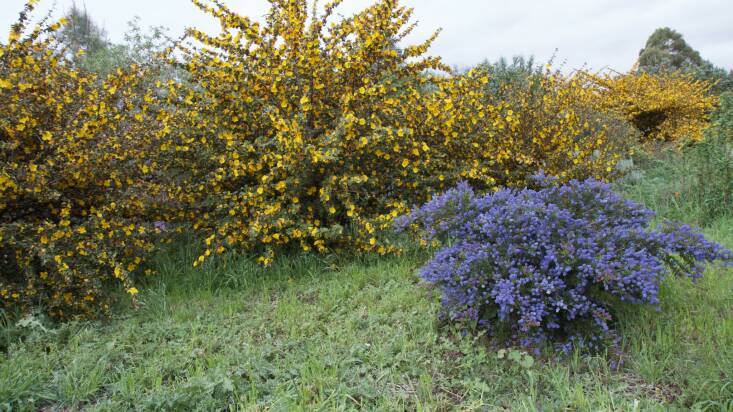Flannel bush, Fremontodendron californicum
With parched conditions in California getting worse with every rain-less day, gardeners here really need to up their drought-tolerant game. This can be tricky as we all want to do our part and be more water-conscious but at the same time, we also want our gardens to look their best. Luckily, there are many unthirsty, really unthristy, plants that are quite generous with their showy blooms. One, in particular, is flannel bush.
Please keep reading to learn about this spectacular, water-saving shrub:

Native to California, this fast growing evergreen shrub is named after John Charles Frémont, who first collected Fremontodendron during an 1846 expedition to California, plus the Greek word dendron, meaning “tree.” This shrub’s leaves, with its fuzzy texture reminiscent of flannel, give this plants its common name. And to be clear, flannel doesn’t mean soft and cozy in this case. In fact, the fuzz (stellate hairs) covering the leaves is extremely irritating to the skin. This means protect your eyes with glasses and wear gloves to protect your skin when planting or pruning this plant. Sort of a buzz-kill, I suppose, but you’ll be rewarded with an abundance of large bowl-shaped yellow flowers in the spring.

Flannel bush will truly show off its glory when given room to grow, as it quickly soars to 20 feet tall and 20 feet wide in about 5 years. For best results, try mimicking this shrub’s native California environment by planting it in a warm, sunny spot in very well-draining, sandy soil. Also, a choice spot is about 10 feet away from a creek or irrigated area so it can reap the distant water rewards. Pro Tip: To avoid a super unhappy shrub (translation: it will croak) avoid irrigating it during the summer months.
Before you write off flannel bush because it sounds too fussy, know that it won the Award of Garden Merit from the California Horticultural Society in 1965 and received a First Class Certificate from the Royal Horticultural Society in 1967.
Popular hybrids to consider:
‘California Glory’ This variety is super robust, reaching 20 feet tall and wide with 3-inch lemony-hued cup shaped flowers with a reddish outer petal tinge. Blooms profusely in spring and summer. Hardy to about 15 degrees F.
‘Ken Taylor’ reaches a moderate 4 to 5 feet tall and 6 to 8 feet wide with golden yellow blooms.
‘Dara’s Gold’ is an attractive, low-mounding shrub that tops out at 3 feet tall but spreads to 6 feet or so. This variety has glossier green leaves and more full-on yellow color without the typical orange undertone. It’s a smart candidate for uphill slopes, as you can fully appreciate the nodding, sunny blooms.
Cheat Sheet
- Supports important bee and butterfly populations.
- Make sure to plant this shrub away from walkways and where people might accidentally brush up against the hairy leaves.
- Looks lovely when paired with blue Ceanothus and Salvias.
- Great for creating unique hedges, and when added to deer-resistant or bee-friendly gardens.
Keep It Alive

- Plant this shrub in a sunny spot.
- Ensure your soil is well-draining and preferably sandy. If you don’t have sandy soil, amend your existing soil with horticultural sand. This shrub also tolerates serpentine soils.
- Provide no supplementary water once established. Summer irrigation will speed growth in the beginning but will also drastically shorten its lifespan. When in doubt, don’t water it.
- Avoid giving this plant a hard pruning.
- Luckily this plant is plagued with few pest problems.
For more on drought-tolerant plants, see:
- Flavorful and Fragrant: 5 Top Drought-Tolerant Herbs to Plant Now
- 11 Ideas to Steal from Drought-Tolerant Gardens
- Required Reading: Ruth Bancroft’s Bold Dry Garden









Have a Question or Comment About This Post?
Join the conversation